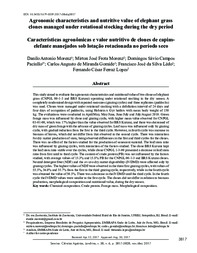Agronomic characteristics and nutritive value of elephant grass clones managed under rotational stocking during the dry period.
Agronomic characteristics and nutritive value of elephant grass clones managed under rotational stocking during the dry period.
Author(s): MORENZ, D. A.; MORENZ, M. J. F.; PACIULLO, D. S. C.; GOMIDE, C. A. de M.; LEDO, F. J. da S.; LOPES, F. C. F.
Summary: This study aimed to evaluate the agronomic characteristics and nutritional value of two clones of elephant grass (CNPGL 00-1-3 and BRS Kurumi) operating under rotational stocking in the dry season. A completely randomized design with repeated measures (grazing cycles) and three replicates (paddocks) was used. Clones were managed under rotational stocking with a defoliation interval of 24 days and four days of occupation of paddocks, using Holstein x Gyr heifers with mean body weight of 150 kg. The evaluations were conducted in April/May, May/June, June/July and July/August 2010. Green forage mass was influenced by clone and grazing cycle, with higher mean value observed for CNPGL 03-01-00, which was 17% higher than the value observed for BRS Kurumi, and there was decreased of dry mass of green forage with the advance of grazing cycles. Leaf mass was influenced only by grazing cycle, with gradual reduction from the first to the third cycle. However, in fourth cycle was increase in biomass of leaves, which did not differ from that observed in the second cycle. There was interaction for dry matter production of stem, being observed differences in the first and third cycles for the clones. There was no effect of the factors studied for the production of senescent material. The leaf:stem ratio was influenced by grazing cycles, with interaction of the factors studied. The clone BRS Kurumi kept the leaf:stem ratio stable over the cycles, while clone CNPGL 1-3-00 presented a decrease in leaf:stem ratio from first until to third cycle. The content of crude protein (PB) was not influenced by the factors studied, with average values of 15.3% and 15.8% PB for the CNPGL 00-1-3 and BRS Kurumi clones. Neutral detergent fiber (NDF) and the in vitro dry matter digestibility (IVDMD) were affected only by grazing cycles. The highest values of NDF were observed in the three first grazing cycles, with values of 55.5%, 56.0% and 55.7% from the first to the third grazing cycle, respectively, while in the fourth cycle was obtained the value of 50.5%. There was a decrease in the IVDMD until the third cycle. In the fourth cycle the IVDMD values were similar to the first cycle. The clones did not differ in relation to biomass production, morphological composition and nutritional value, during the dry season.
Publication year: 2017
Types of publication: Journal article
Unit: Embrapa Dairy Cattle
Observation
Some of Embrapa's publications are published as ePub files. To read them, use or download one of the following free software options to your computer or mobile device. Android: Google Play Books; IOS: iBooks; Windows and Linux: Calibre.
Access other publications
Access the Agricultural Research Database (BDPA) to consult Embrapa's full library collection and records.
Visit Embrapa Bookstore to purchase books and other publications sold by Embrapa.

